*NURSING > QUESTION PAPER & MARK SCHEME > Final Study Guide. Nursing Guide Questions and answers.LATEST PREVIEW. Graded A+ (All)
Final Study Guide. Nursing Guide Questions and answers.LATEST PREVIEW. Graded A+
Document Content and Description Below
For which of the following patients is foot care likely the highest priority? A - A patient who has experience postoperative pneumonia and has been placed on a ventilator B - A patient who has bee ... n diagnosed with Alzheimer disease and whose mobility is decreasing C - A patient who is obese and has a diagnosis of type 1 diabetes D - A patient who has chronic renal failure and requires hemodialysis three times weekly. - Ans-C - A patient who is obese and has a diagnosis of type 1 diabetes A nurse is caring for a client with a history of cardiac and vascular disease. Which of the following fats should the nurse allow in the client's diet for his condition? a) Unsaturated fats b) Saturated fats c) Hydrogenated fats d) Trans fats - Ans-A - Unsaturated Fats The nurse has observed that a patient's food intake has diminished in recent days. What intervention should the nurse perform in order to stimulate the patient's appetite? a) Offer nutritional supplements and explain the potential benefits of each. b) Reduce the frequency of meals in order to allow the patient to develop an appetite. c) Offer larger meals and encourage the patient to eat as much as he or she is comfortable with. d) Try to ensure that the patient's food is attractive and sufficiently warm. - Ans-D - Try to ensure that the patient's food is attractive and sufficiently warm. A client who has bleeding tendencies has a deficiency in which vitamin? a) Vitamin B b) Vitamin C c) Vitamin K d) Vitamin A - Ans-C - Vitamin K The nurse caring for a patient for several days has assessed that he has been eating poorly during his hospitalization. Which nursing measure should the nurse implement to assist the patient in improving his nutritional intake? a) Encourage his daughter to prepare food at home and bring it to the patient. b) Provide bland meals. c) Provide distractions while the patient is fed so that he will eat more. d) Serve large meals and encourage the patient to eat as much as possible. - Ans-A - encourage his daughter to prepare food at home and bring it to the patient. A nurse is caring for a client with a wound infection. The dietician has prescribed a diet rich in vitamin A. The client asks the nurse, "Why do I need Vitamin A?" The nurse integrates an understanding of which of the following as a major reason when responding to the client? a) It helps maintain healthy epithelium b) It maintains normal mineralization of cartilage c) It promotes renal reabsorption of calcium d) It mobilizes phosphorus from bone - Ans-A - It helps maintain healthy epithelium Which of the following is a fat-soluble vitamin? a) Vitamin B12 b) Vitamin B6 c) Vitamin E d) Vitamin C - Ans-C - Vitamin E A nurse is preparing a teaching plan for a client who is obese and has diabetes mellitus. Which of the following would the nurse include when discussing the the effect of diabetes on nutrition? a) Cells cannot use glucose to produce energy. b) The digestion of fats and protein is altered. c) Intolerance to gluten occurs. d) Glucose levels of the blood are reduced - Ans-A - Cells cannot use glucose to produce energy. A 20-year-old woman has announced her intention to implement a zero-fat diet in order to lose weight and maximize her health. What is a potential consequence of completely eliminating fat sources from the woman's diet? a) Decreased production of antibodies b) Decreased water absorption in the colon c) Impaired vitamin absorption d) Impaired tissue growth and repair - Ans-C - Impaired vitamin absorption A nurse is caring for a pregnant client who is a strict vegetarian. What type of diet should the client follow? a) A diet rich in sodium b) A diet rich in protein c) A diet lower in calcium and iron d) A diet rich in fat - Ans-B - A diet rich in protein You are caring for a patient who has dysphagia and is unable to eat independently. You are preparing to assist the patient in eating a meal. Which of the following actions is appropriate? a) Create a positive social environment by asking the patient about childhood food memories. b) Arrange food items in a clock face pattern and inform the patient what time on a clock corresponds to each food item. c) Encourage the patient to eat using a consistent, efficient pace to prevent hot foods from becoming too cool and cool foods from becoming too warm. d) Speak to the patient but limit the need for the patient to respond verbally while chewing and swallowing. - Ans-D - Speak to the patient but limit the need for the patient to respond verbally while chewing and swallowing. A patient is interested in losing 15 pounds, and she informs the nurse she is counting her calorie intake each day. The patient has a goal of losing 1 pound a week until she reaches her goal. The patient asks the nurse how many calories she should decrease daily to lose a pound a week. What is the nurse's best response? a) 300 calories/day b) 400 calories/day c) 200 calories/day d) 500 calories/day - Ans-D - 500 calories/day Which of the following is an appropriate intervention when unexpected situations occur during the administration of a tube feeding? a) If the patient complains of nausea after tube feeding, lower the head of the bed and administer an antiemetic. b) If the tube becomes clogged when aspirating contents, use warm water and gentle pressure to remove the clog. c) If the tube is found to be in the stomach instead of the esophagus, follow the recommended steps to replace the tube. d) When checking for residue, if a large amount is aspirated, replace the residue before feeding. - Ans-B - If the tube becomes clogged when aspirating contents, use warm water and gentle pressure to remove the clog The AACN has provided a directive regarding best practice for verification of feeding tube placement. Which of the following is NOT an expected practice for tube placement? a) Bedside techniques, including measuring the pH and observing the appearance of fluid withdrawn from the tube, should be used to assess tube location at regular intervals. b) The mark on the tube's entrance site to the nose or mouth should be observed routinely to assess for a change in length of the external portion of the tube. c) Radiographic confirmation of correct tube placement on all critically ill patients who are to receive feedings or medications via blindly inserted gastric or small bowel tubes following initial use. d) The tube's entrance site to the nose or mouth should be marked and the length documented immediately after radiographic confirmation of correct tube placement. - Ans-C - radiographic confirmation of correct tube placement on all critically ill patients who are to receive feedings or medications via blindly inserted gastric or small bowel tubes following initial use. Which of the following is an accurate step when removing a nasogastric tube? a) Before removing the tube, discontinue suction and separate the tube from suction. b) Attach a syringe and flush with 30 mL of water or normal saline solution. c) Place the patient in a protective supine position. d) Quickly and carefully remove tube while the patient breathes out. - Ans-A - Before removing the tube, discontinue suction and separate the tube from suction. Regarding medication administration, what must occur at the change of shifts? a) The narcotics for the division are counted b) The LPNs only on the division count medications c) The medications for the division are counted d) The client's medications must be drawn up - Ans-A - The narcotics for the division are counted What is involved in the absorption, distribution, metabolism, and excretion of medication? a) Pharmacodynamics b) Pharmacotherapeutics c) Pharmacology d) Pharmacokinetics - Ans-D - Pharmacokinetics A nurse is caring for a client who is being tube fed. What care should the nurse take when administering medications through an enteral tube? a) Avoid crushing sustained-release pellets b) Add medications to the formula c) Use cold water when mixing powdered medications d) Mix all the medications together in 15 mL of water - Ans-A - avoid crushing sustained-release pellets If the dosage is inappropriate for a client, who is responsible? a) Nurse b) Medical technician c) Physician d) Pharmacist - Ans-A - Nurse Which one of the following medications would most likely be administered via a transdermal patch? a) Hormonal medications b) Antidepressants c) Antibiotics d) Epinephrine - Ans-A - Hormonal medications A nurse is caring for a client undergoing IV therapy. The nurse knows that intravenous administration of medication is appropriate in which of the following situations? a) When the drug needs to be administered only once b) When the client wants to avoid the discomfort of an intradermal injection c) When the drug needs to act on the client very slowly d) When the client has disorders that affect the absorption of medications - Ans-D - When the client has disorders that affect the absorption of medications At what point should the nurse perform the first of the three checks of medication administration? a) When reviewing the patient's medication administration record (MAR) b) After retrieving the drug from the drawer of a drug cart c) As the nurse reaches for the drug package or container d) At the beginning of a shift - Ans-C - As the nurse reaches for the drug package or container A nurse is using an 18-gauge needle to administer a medication to a client. The nurse knows that when compared to a 27-gauge needle, an 18-gauge needle has which of the following features? a) Shorter length b) Greater length c) Smaller diameter d) Larger diameter - Ans-D - Larger Diameter [Show More]
Last updated: 3 years ago
Preview 1 out of 256 pages
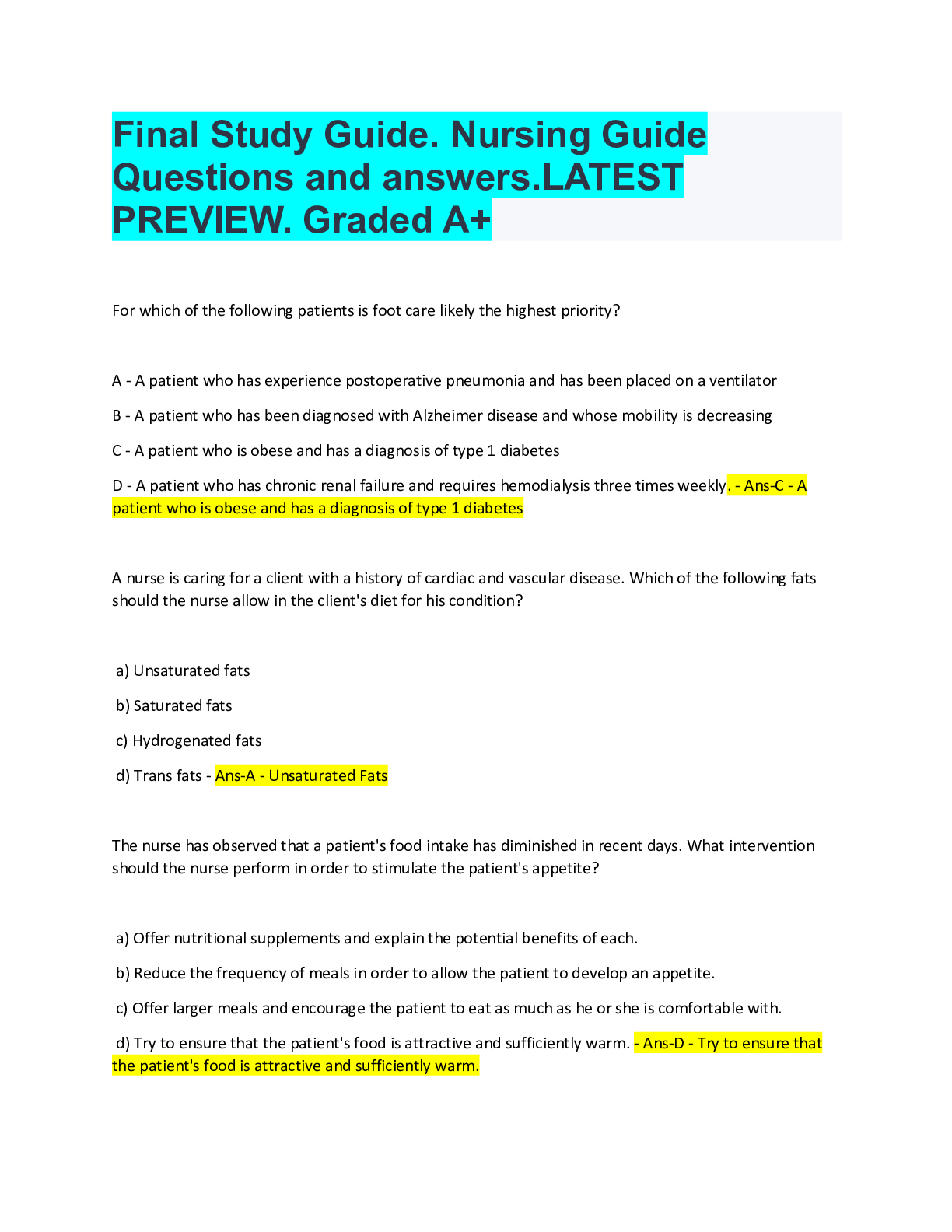
Buy this document to get the full access instantly
Instant Download Access after purchase
Buy NowInstant download
We Accept:

Reviews( 0 )
$12.00
Can't find what you want? Try our AI powered Search
Document information
Connected school, study & course
About the document
Uploaded On
Jun 10, 2022
Number of pages
256
Written in
All
Seller

Reviews Received
Additional information
This document has been written for:
Uploaded
Jun 10, 2022
Downloads
0
Views
118
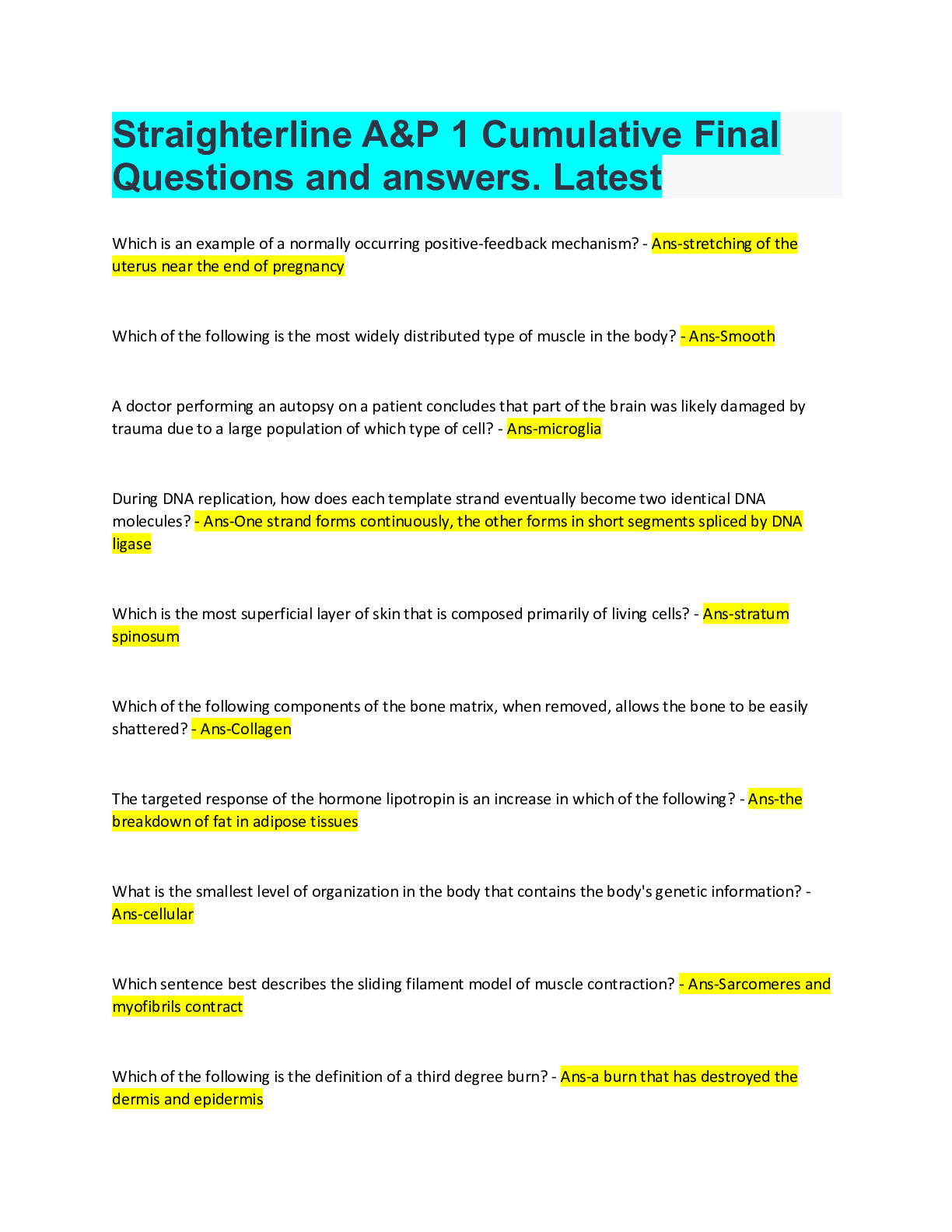
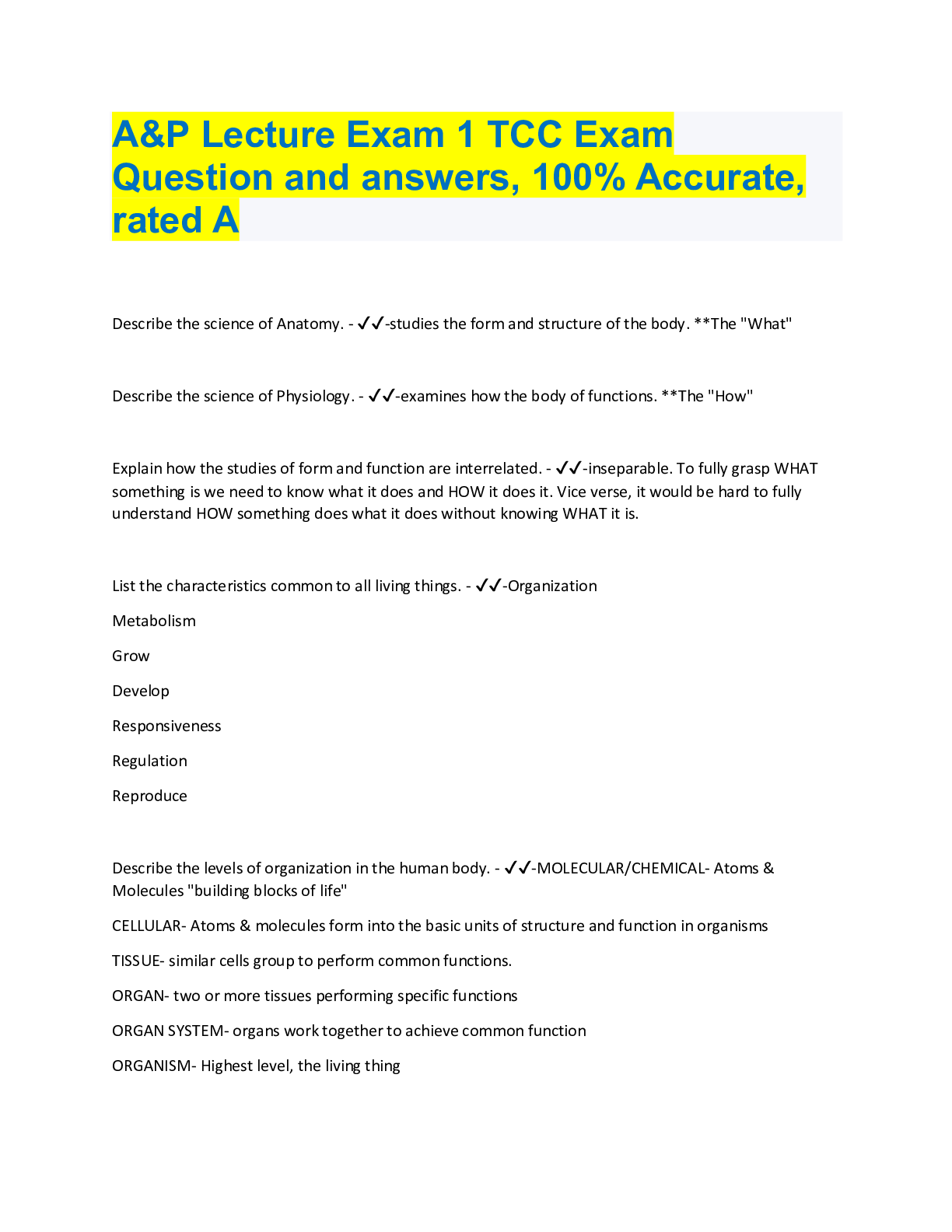
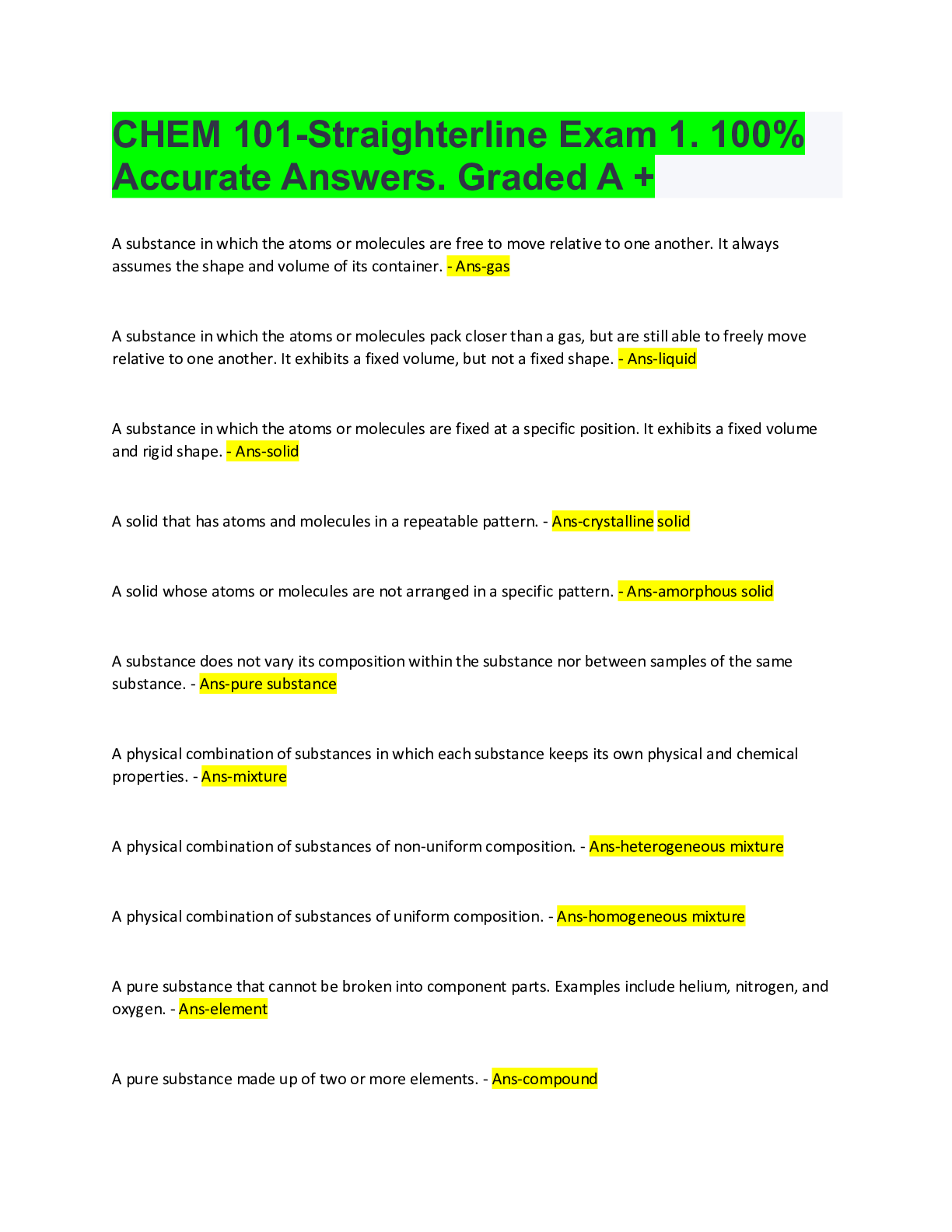


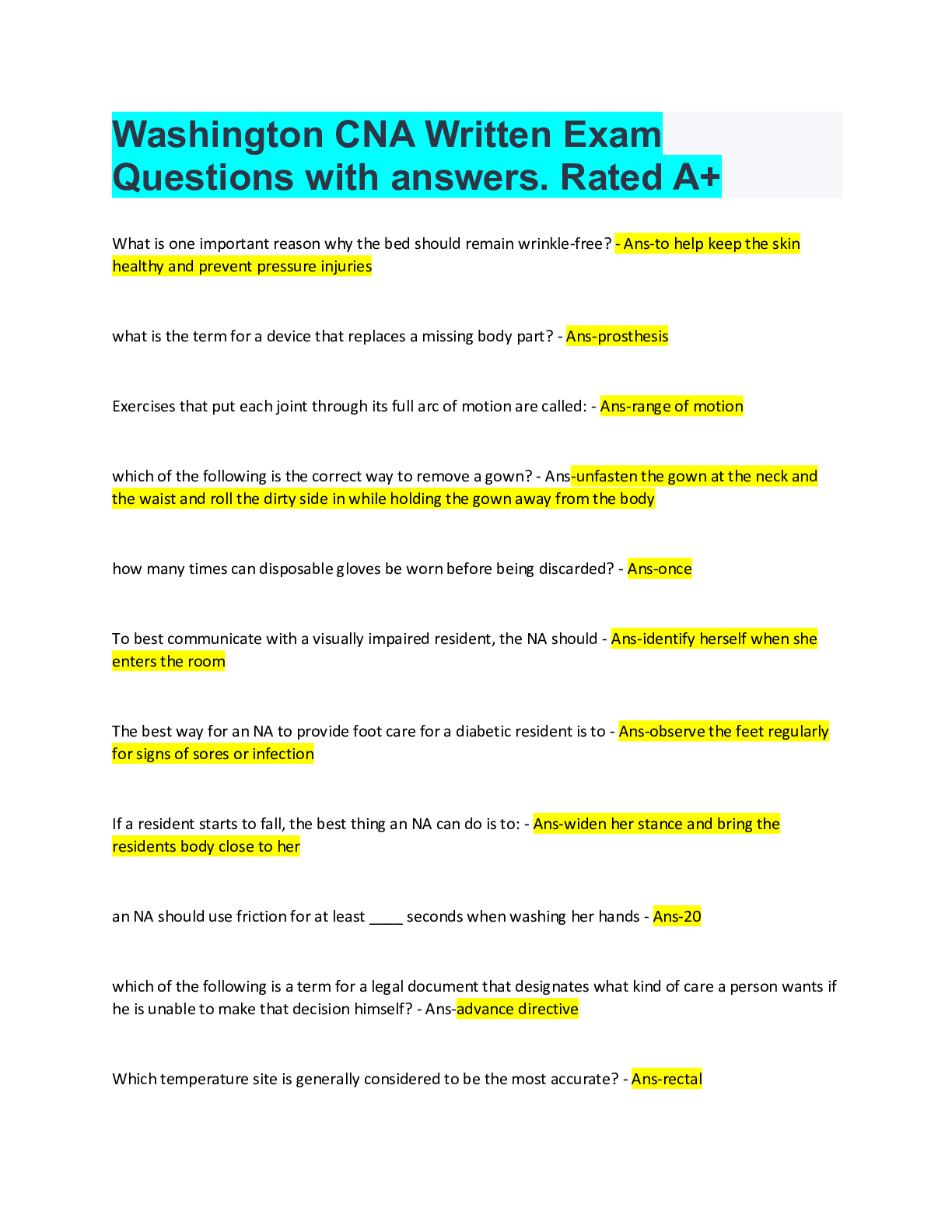
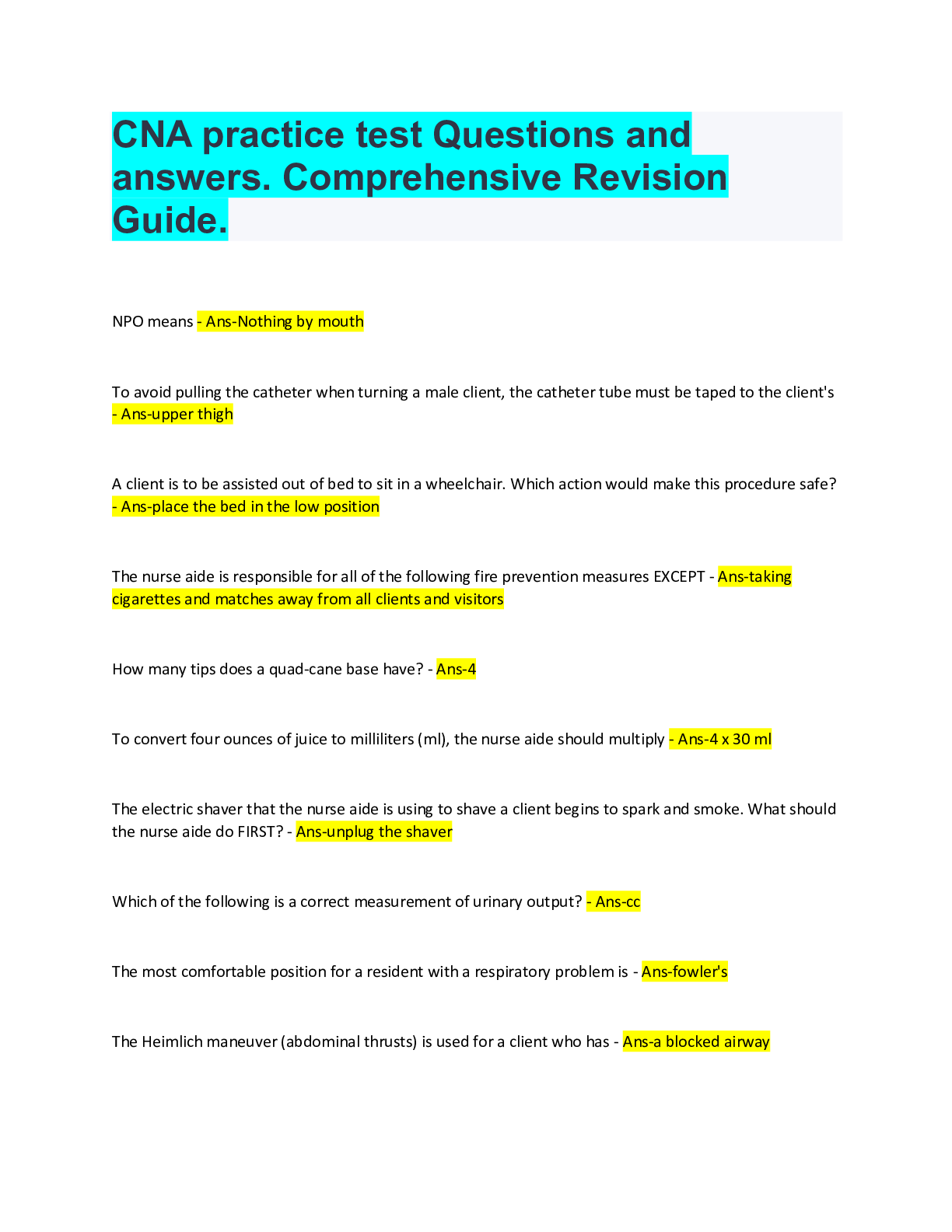

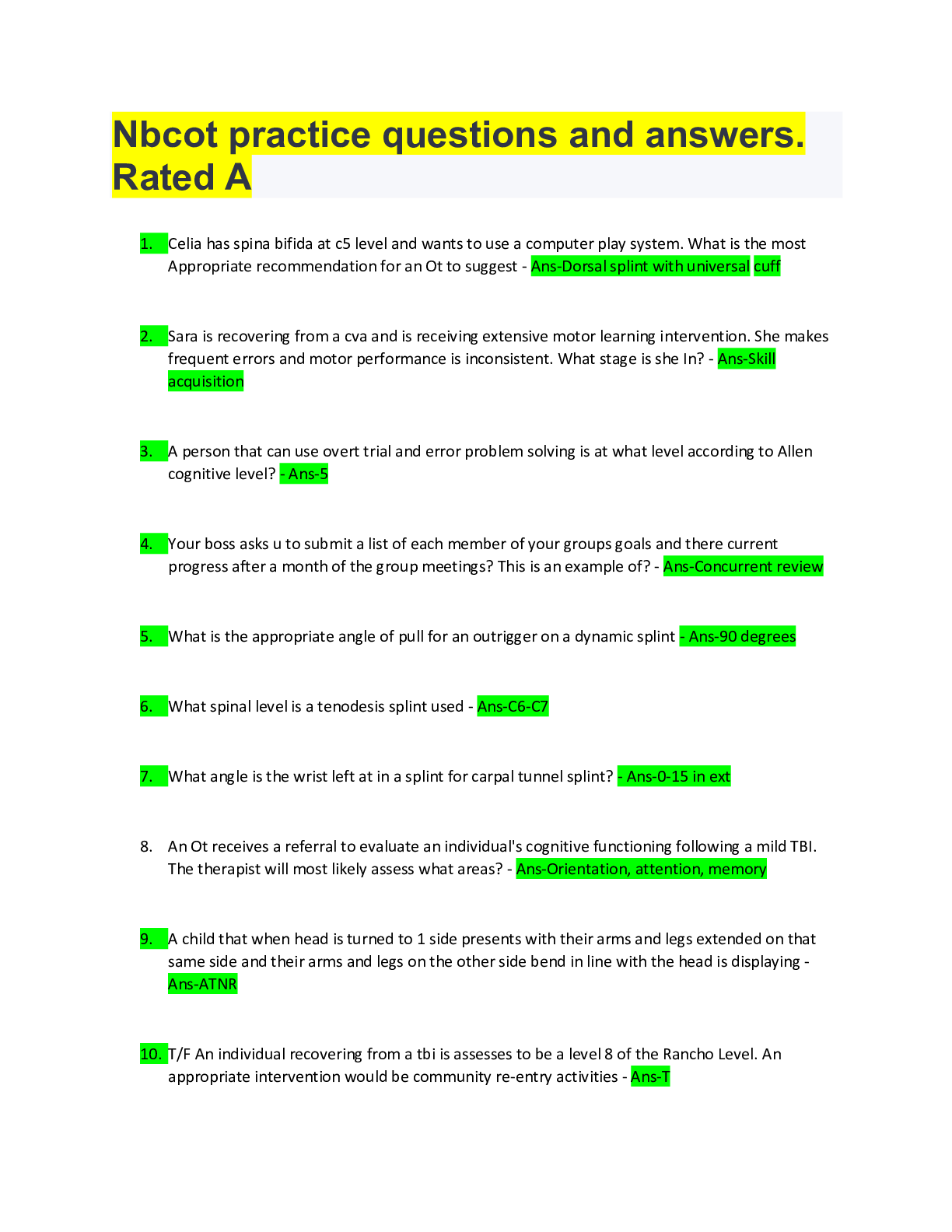
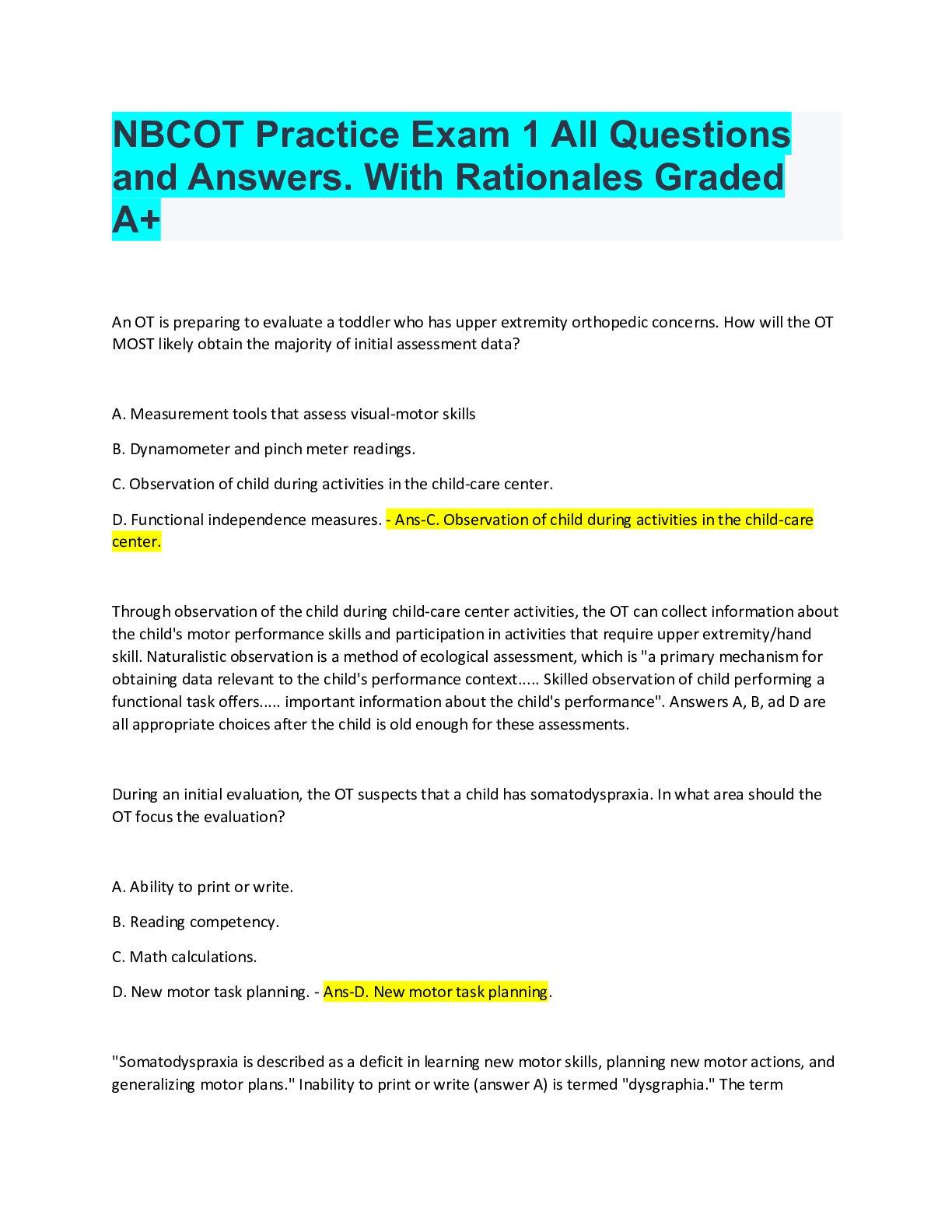
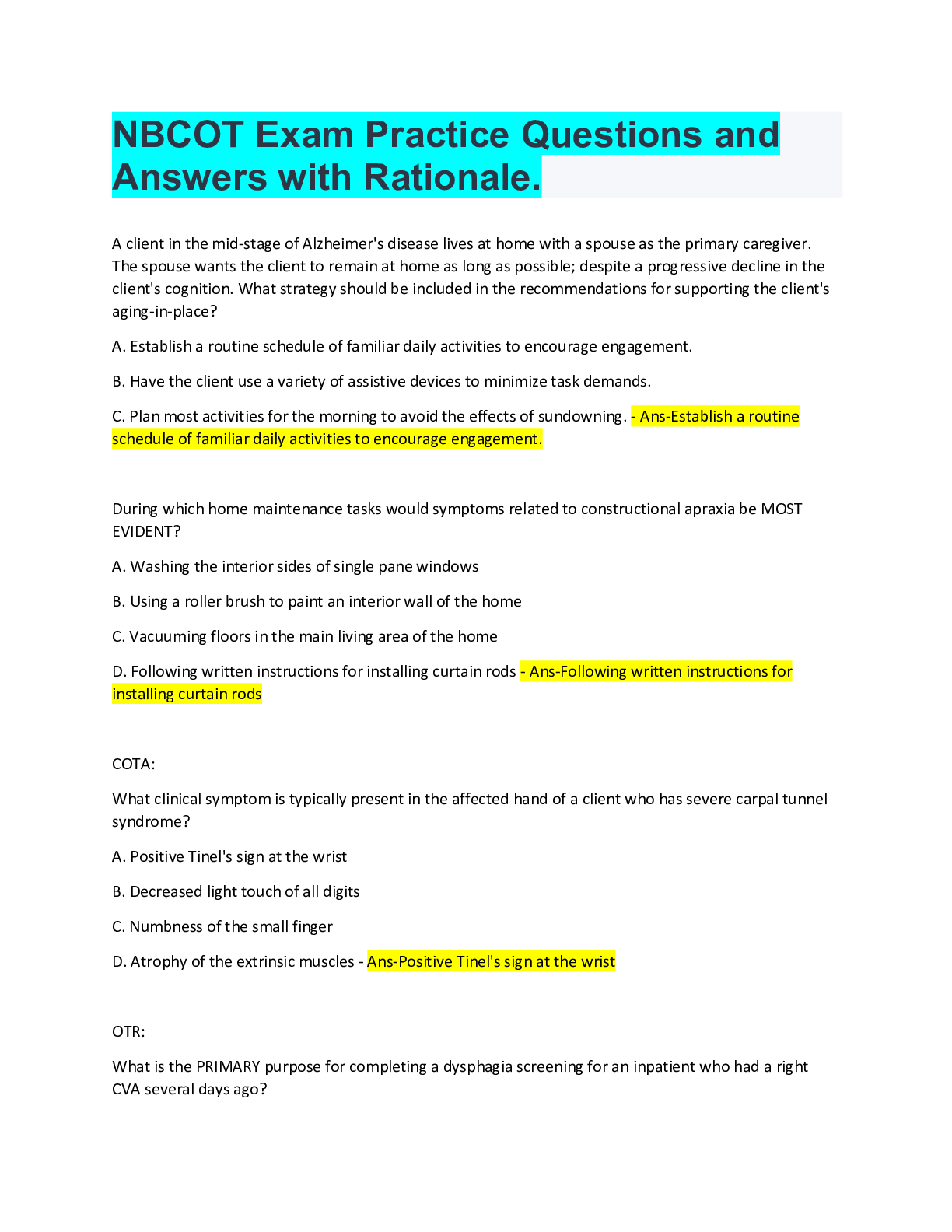
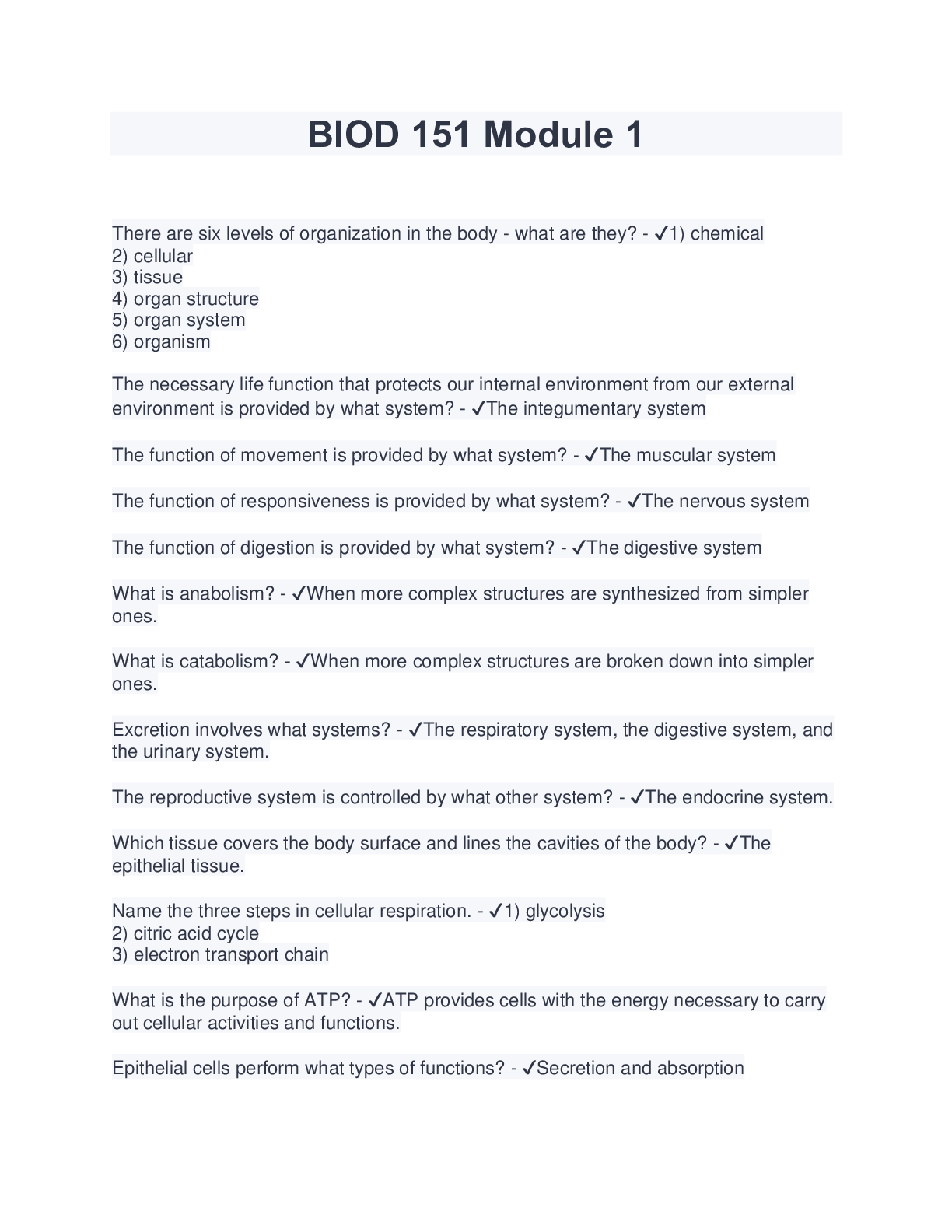
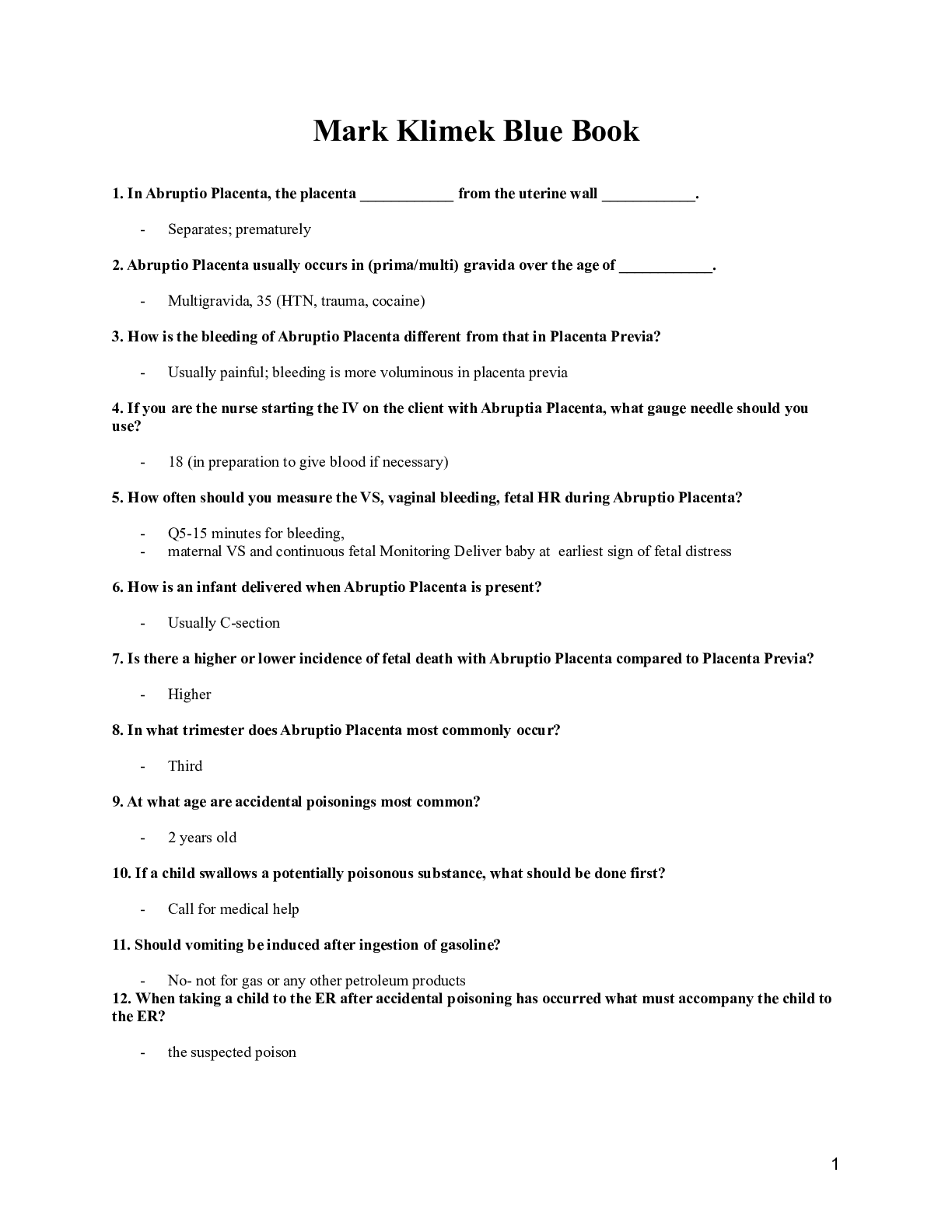
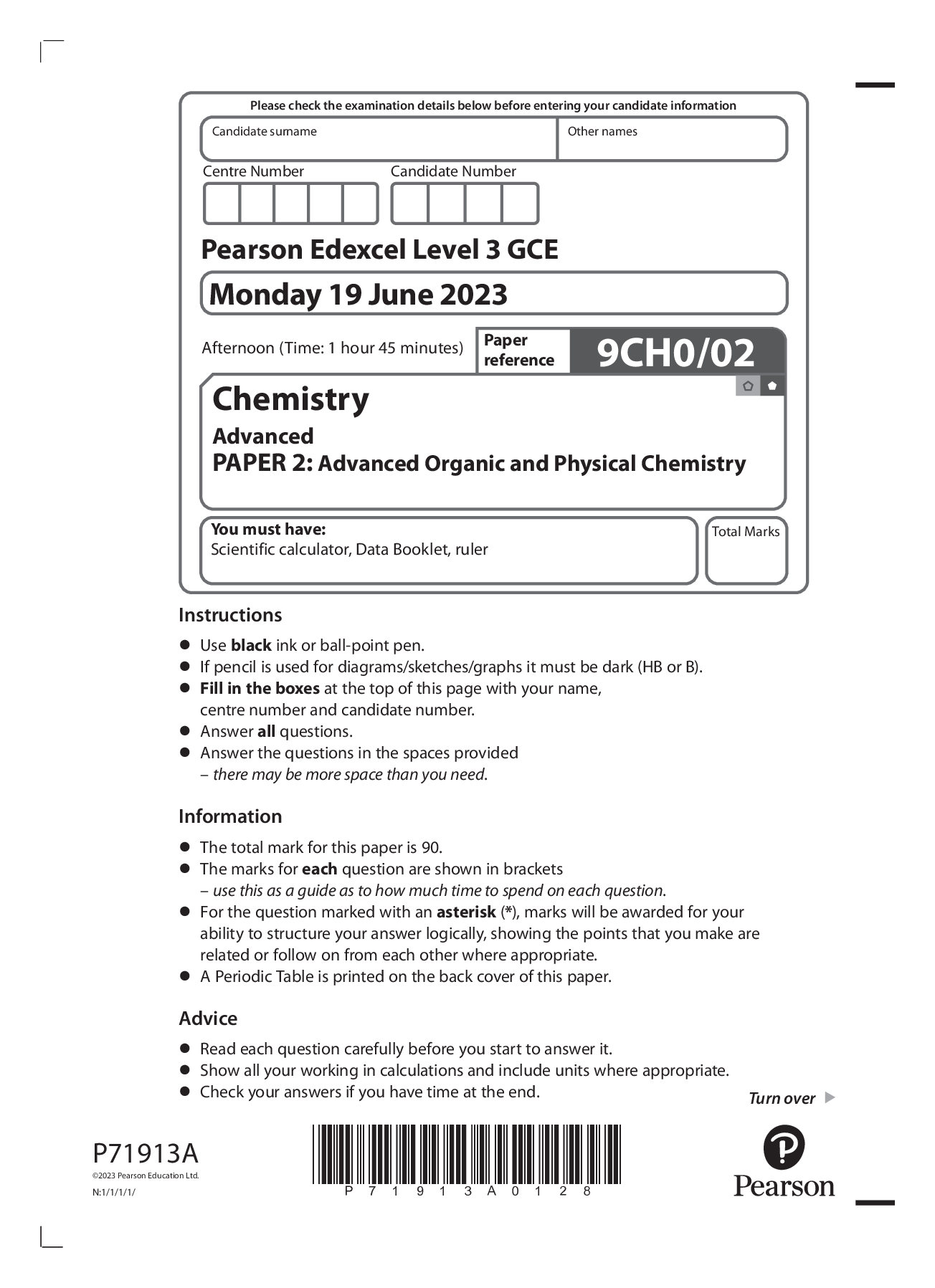




.png)
.png)

